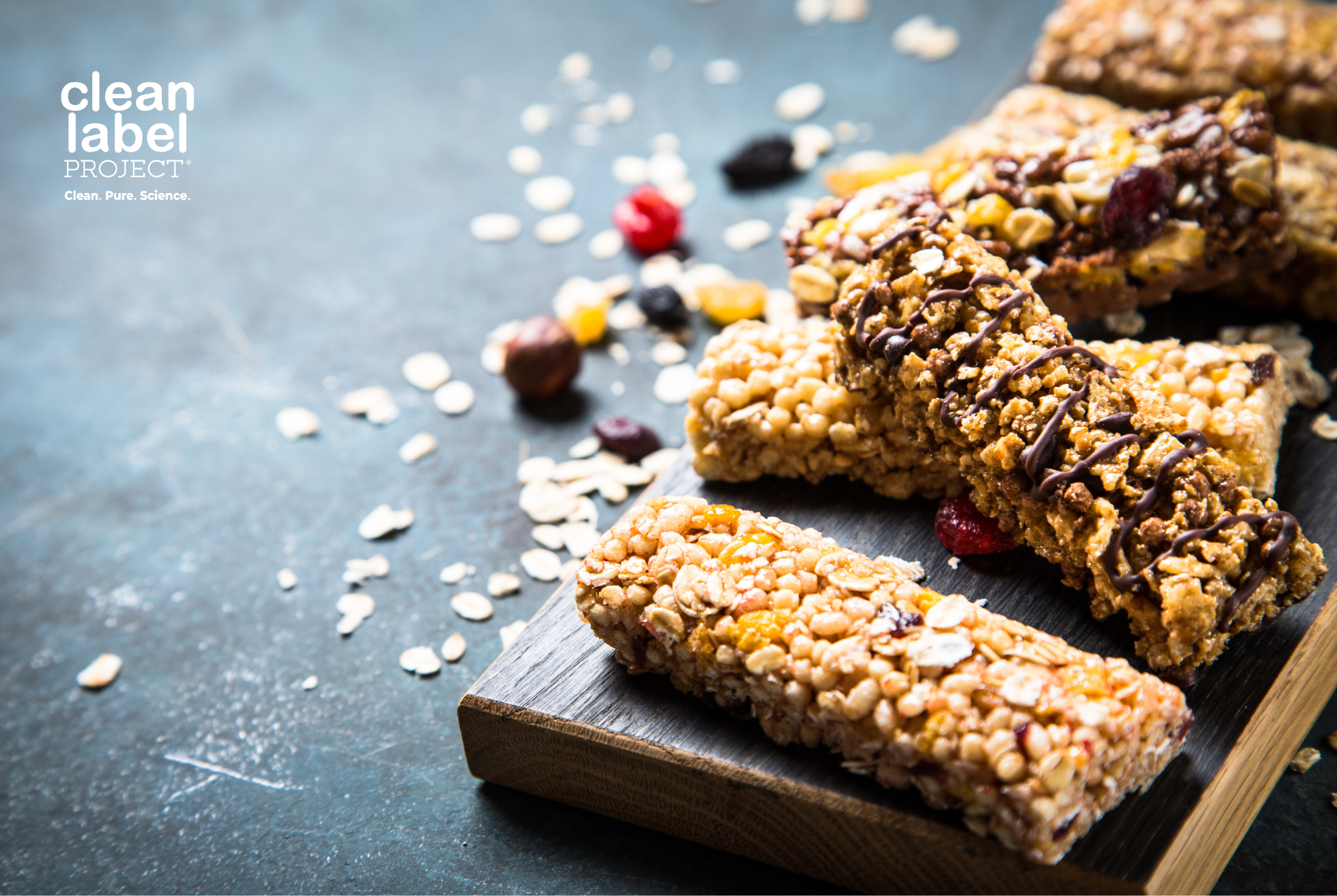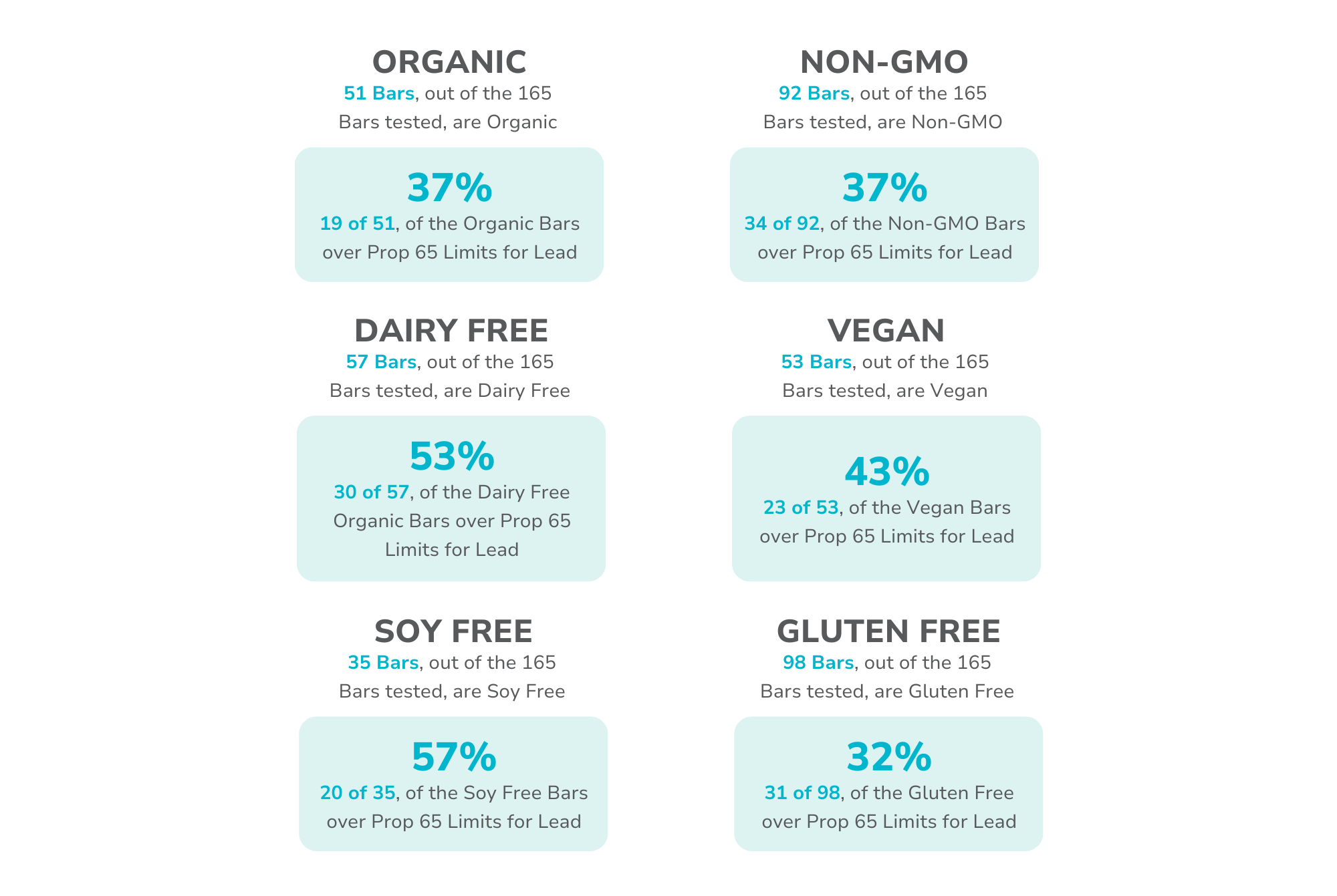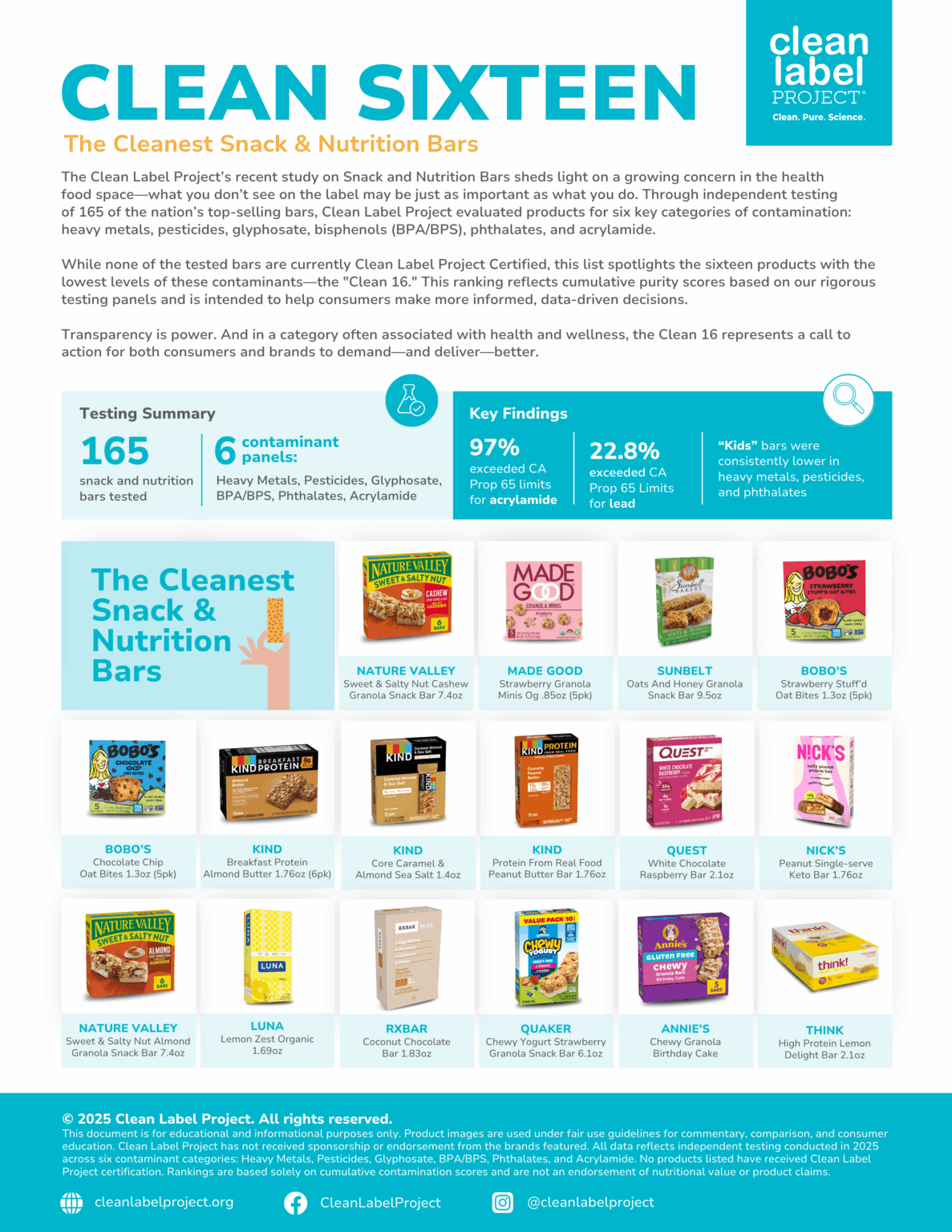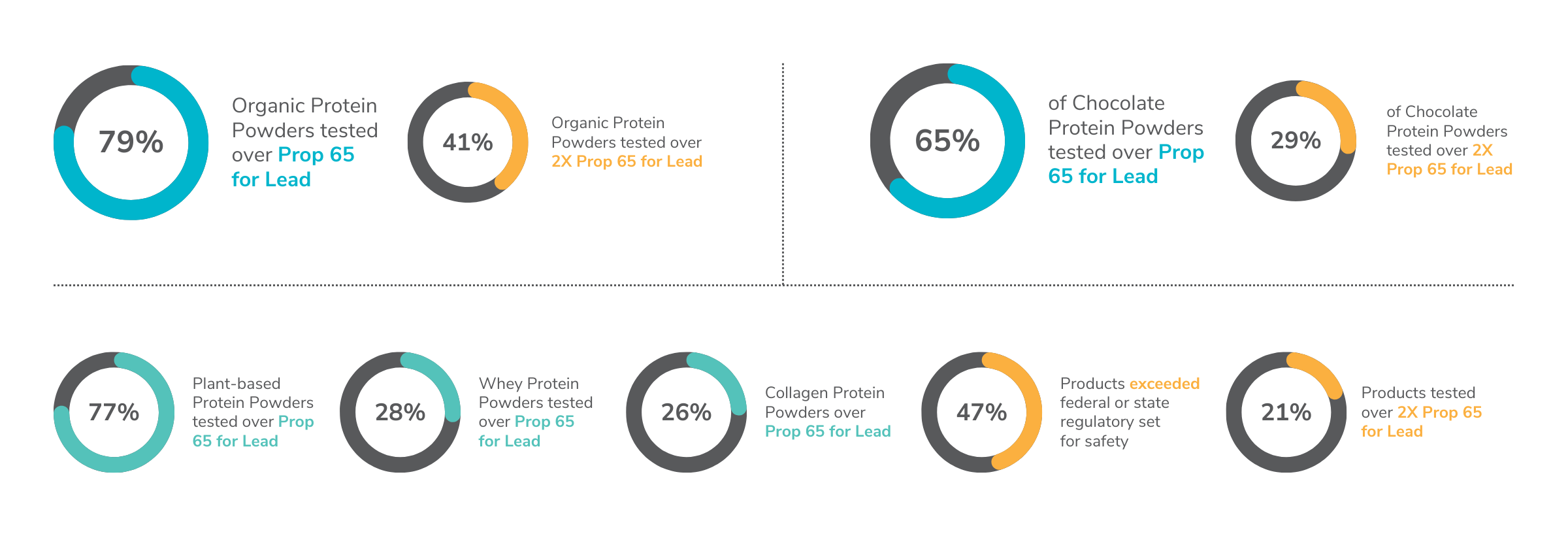


Snack and Nutrition Bars are one of the most popular snacks and dietary supplements in the U.S., generating $7.4 billion in 2024. While people use it for a quick snack and meal replacement, they all complement and supplement their already healthy lifestyle choices and have certain safety and quality expectations. At Clean Label Project, rather than accepting safety as a given, we rely on data and science to reveal the truth behind what consumers are really ingesting, focusing on ensuring transparency and safety in the market.
Clean Label Project purchased and rigorously tested 165 of the top-selling Snack and Nutrition Bars (sourced from Nielsen, SPINS and Amazon’s best-seller lists), supplemented with top products from the natural and organic marketplace. It also assessed multiple panels of industrial and environmental contaminants. Collaborating with an analytical chemistry lab, Clean Label Project amassed over 20,000 data points from 50 brands and 165 products to benchmark the findings.

Surprisingly, there are no comprehensive federal regulations specifically targeting dietary exposure to heavy metals in food, with most safety efforts focused on physical and microbiological contaminants. However, recent discussions in Congress and the FDA (with Closer-to-Zero and action limits for baby food) are pushing for stricter standards on heavy metals and industrial chemicals in food products. States like California have led the charge with Prop 65 (which is referenced many times in the Snack and Nutrition Bars white paper) and California and Maryland transparency laws for heavy metals in baby food (CA AB899 & MD SB723). While(CA AB899 & MD SB723)initially focus on infant foods, they signal growing concern over contaminants in food across all categories.
The two primary sources of contaminants in Snack and Nutrition Bars are the contaminated soils where ingredients are grown and the packaging used for these products. At the agricultural level, companies can hold suppliers accountable to minimize pesticide and soil contamination during the growth cycle of their ingredients. However, the good news is that packaging has seen significant improvements in terms of BPA content. Clean Label Project’s testing indicates that BPA has been nearly eliminated from packaging, with only 15% of products having detectable levels. This reflects the industry’s response to consumer demand and controversy surrounding this chemical.
13Clean Label Project contracted the independent, ISO/IEC 17025-accredited analytical chemistry laboratory, Ellipse Analytics, to test six (6) industrial chemical panels, including heavy metals and BPA.
The heavy metals, arsenic, cadmium, lead, and mercury, were tested by Inductively Coupled Plasma – Mass Spectroscopy (ICP-MS). Phthalates were tested by Gas Chromatography – Mass Spectroscopy (GC-MS/MS). Bisphenols and pesticides are tested by Liquid Chromatography – Tandem Mass Spectroscopy (LC-MS/MS).
Our mission is to empower consumers to see beyond flashy marketing. When it comes to selecting low-contaminant options, our recommendation is to purchase bars labeled as “Kids” as they were lower in Heavy Metals, Pesticides and Phthalates.

Clean Label Project purchased and rigorously tested 160 of the top-selling protein powders, sourced from Nielsen and Amazon’s best-seller lists, and supplemented with top products from the natural and organic marketplace. It also assessed multiple panels of industrial and environmental contaminants. Collaborating with an analytical chemistry lab, Clean Label Project amassed 35,862 data points from 70 brands and 160 products to benchmark the findings.
Protein powders tested by Clean Label Project had an array of positive results for levels of arsenic, cadmium, lead, and mercury. However, 47% of products exceeded at least one federal or state regulatory set for safety, including CA Prop 65, and 21% of the samples were over 2X CA Prop 65 levels.
– Heavy metals, such as arsenic, lead, mercury, and cadmium, are naturally occurring elements found in the Earth’s crust.
They enter the environment through natural processes like volcanic eruptions, weathering of rocks, and soil erosion. Over time, they accumulate in air, water, and soil, where they can make their way into plants, animals, and eventually into human food sources. Though naturally occurring, the concentration of these metals can increase due to human activities such as mining, industrial processes, and agricultural practices, leading to higher exposure risks in food products. Given the absence of federal regulations that require proactive testing to minimize the introduction into finished products, they can be unintentionally introduced into all foods and consumer products. Interestingly, certified organic products were found to have, on average, three times the lead compared to non-organic products. This was largely due to plant-based protein powders, which tend to contain higher levels of contaminants. Our studies continue to report chocolate as a high-risk ingredient.
– 65% of Chocolate Protein Powders tested over Prop 65 levels and 29% tested over 2X Prop 65.

Bisphenols, including BPA and BPS, are well-known endocrine disruptors with significant health risks. Research has shown that BPA can interfere with insulin tolerance, potentially undermining athletic training efforts for those using protein powders (Moon et al., 2015). Additionally, BPA is linked to metabolic issues, increasing the risk of type II diabetes (Le Magueresse-Battistoni et al., 2018). Fortunately, Clean Label Project’s 2023-2024 study found a significant improvement from 2018, with BPA and BPS detected in only 3 of 160 protein powder products, compared to 55% in previous tests. Plant-based protein powders were the most contaminated, containing five times more cadmium than their whey-based counterparts. Even the flavor of protein powder played a significant role in contamination levels. Chocolate protein powders, for instance, were found to have a staggering 110 times more cadmium [1] than vanilla-flavored varieties. Meanwhile, whey-based protein powders generally showed much lower contaminant levels, highlighting the variability in product safety depending on the protein source and flavoring.
Surprisingly, there are no comprehensive federal regulations specifically targeting dietary exposure to heavy metals in food, with most safety efforts focused on physical and microbiological contaminants. However, recent discussions in Congress and the FDA are pushing for stricter standards on heavy metals and industrial chemicals in food products. States like California have created regulations, like Prop 65 that we reference. Prop 65 requires businesses to provide warnings about significant exposures to chemicals that cause cancer, birth defects or other reproductive harm. CA and MD have led the charge with transparency laws for heavy metals in baby food (CA AB899 & MD SB723).
The two primary sources of contaminants in protein powders are the contaminated soils where ingredients are grown, and the packaging used for these products. At the agricultural level, companies can hold suppliers accountable to minimize pesticide and soil contamination during the growth cycle of their ingredients. However, the good news is that packaging has seen significant improvements in terms of BPA content. Clean Label Project’s testing indicates that BPA has been nearly eliminated from packaging, reflecting the industry’s response to consumer demand and controversy surrounding this chemical.
Clean Label Project contracted an independent analytical chemistry laboratory, Ellipse Analytics, to test 6 industrial chemical panels, including heavy metals and BPA.The heavy metals, arsenic, cadmium, lead, and mercury, were tested by Inductively Coupled Plasma–Mass Spectroscopy (ICP-MS). Bisphenols and pesticides are tested by liquid Chromatography–Tandem Mass Spectroscopy (LC-MS/MS).
Our mission is to empower consumers to see beyond flashy marketing. When it comes to selecting low-contaminant options, our findings reveal that plant-based protein powders generally had the highest levels of detected contaminants, while whey-based protein powders consistently demonstrated lower levels. The data from this protein study, enables consumers to make informed choices that prioritize safety and quality in their dietary supplements. Based on our study, the products with the least lead are whey or collagen-based protein powders that are not chocolate-flavored.
The following companies have protein powders that are Clean Label Project Certified:
Stay tuned as more brands are currently going through the Certification Process.
“The food industry owes their customers an open, honest, and transparent view of how clean their ingredients are,” explains Jaclyn Bowen from Clean Label Project. “Consumers are purchasing supplement and protein products for health and performance, they expect the products to be clean.”
Transparency laws like CA AB899 and Maryland “Rudy Law” is the future for consumer trust and industry change. Clean Label Project has a Transparency certification that displays the results of all certified brands lots providing consumers with the confidence to make the right informed decisions. We believe there is a growing concern about food and supplement safety and a growing demand for transparency.
Currently only one protein company, Puori, is certified to Clean Label Project Transparency Certification but we encourage more brands to seek Transparency Certification providing consumers with the trust they deserve.